

The Hemp Commerce & Farming Report
Volume 2, Issue 13, August 2000 ISSN 1488-3988
Part II of III
© 2000 AHEM, ARTHUR HANKS
Bulk Wholesale distribution.
Watch for our Retail Product Line launch !!
Distributors, brokers, & retailers welcome! ...the seed you need!™
Hemp Oil Canada, Box 188, Ste. Agathe, MB. ROG 1YO, Canada
Tel: 204-275-7616, Fax: 204-261-7270
Email: hempoilcan@escape.ca , Web site: www.hempoilcan.com
Location, Location, Location (Part II): Seedbed preparation
By Jon Cloud
The hype on hemp has quieted down and now we can get on with building a solid base for our fledgling industry. Last weekend, I was reminded of the tenuous nature of our existence as I walked in a section of the great Canadian forests.
Bear, my Black Labrador Retriever, and I were out "checking things out." As we stepped on to an old logging road we spotted two young Ruffed Grouse nervously shuffling about in the roadway. Unsure of the appropriate response they should be having to the two intruders, one partridge ran for cover and the second bird flew up to a nearby branch. Its young stubby wings could hardly carry it six feet into the air. Landing on the branch it flapped and teetered in an attempt to keep its precarious balance.
The partridge, like our industry, has achieved a perch. However, the skill and strength to survive in the wild environment of retailing will require years of experience by all parts of the industry.
Producers of hemp are no exception to this evolutionary law.
The agricultural component of the industry has experienced a great setback with the tragedy that occurred in Manitoba last year. It is, in the end, a hard lesson but valuable never the less. Other lessons are taught more on a field by field basis. The location of the physical plot, discussed in detail in the last article, came as a hard lesson for few farmers last year. This year we struggle to apply the techniques of planting hemp in the right type of soil. This is the second location in the three tenets of hemp production: Location, Location, Location.
Seedbeds are an esoteric topic within the agricultural community. Discussed in terminology that makes little sense to non-farmers, we struggle like physicists with particle size and the techniques to reduce these particles into a manageable uniformity to produce an environment conducive to good germination and rapid emergence. Hemp will not tolerate short cuts in seedbed preparation. The soil particle size must be fine to facilitate the soil to seed contact for uniform planting depth and emergence. This depth changes with the weather, as deeper planting is required for the drought cycle years than the years carrying more moisture.
In ideal conditions this depth should be three times the depth of the seed. Since we are dealing with a small seed (compared to a soybean) and substandard germination rates (70%) the soil moisture is of paramount consideration. The seedbed must be levelled and provide as consistent a depth as possible. A fine seedbed provides a greater opportunity to accomplish this task.
Soil to seed contact is further enhanced with a packer or roller to firm the soil around the seed. A firmed soil helps eliminate some of the excess air space around the individual soil particles. This retards the rapid drying of the soil and ultimate demise of the plant. This is particularly important to the fragile rooted hemp plant during its emergence. The root must have the opportunity to get established during its first two weeks of life.
Hemp is considered a hardy plant. However, this is not the case during the first two weeks. Many other plants — soybeans, corn and wheat — are far less susceptible to Mother Nature's whims when compared to hemp. Thus, the soil types you select for planting are very important.
Sandy soils will provide too much air space and not provide the protection hempseeds require for a good even profitable stand. Heavy clay soils can prevent the tender wispy young root from penetrating so sufficient depth to afford the protection during those early weeks.
The myth about hemp being able to grow anywhere has misled many people to think that it can grow anywhere profitably. Like most crops it does best in a well drained sandy loam or loam soil. The heavier the ground, the poorer the yield. Poorly drained soils will experience poor yields, as hemp does not like cold wet feet. So don't plant hemp if you have a field that has always been rank and so rough you can hardly put a tractor on it. Give hemp a decent soil that is well drained with a good fine seedbed and you will have a profitable experience.
Jon Cloud is an Ontario-based organic farmer, contractor and educator who is a frequent contributor to the HCFR. He can be reached at cloudmtn@interlog.com.
Harvesting, Handling and Storage: A Checklist
By Sasha Przytyk
Harvesting Tall/Fibre Hemp:
Raise cutter bar, reduce intake
Reduce straw chopper
Shield moving parts; Danger of fibre wrapping and plugging
Must straight-combine at high moisture: 20-30%
Harvest when approx. 60-70% mature
Aeration bin required to bring moisture under 10%
Hemp swather/kemper or heavy duty cutter/mower
Swath turner or tedder
Heavy duty square baler or modified round baler
Bale handling equipment
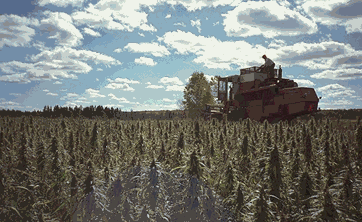
Harvesting short variety - Fin 314 "seed" hemp:
Standard harvesting equipment may be used
No modifications — conventional or rotary combine
Reduce rotor cylinder speeds
Swath when shattering is first noticed (85% maturity)
Cut at 10-12inches form the ground
Combine at 10% moisture or less
Straw is shredded and may be easily baled or incorporated back into soil
Grain Market demands quality. Some considerations:
High oil content (30%)
High germination
Dry (<10%)
Freshness and Purity (99%)
< 10 ppm, THC
Deductions are possible for sclerotinia content; high green seed content; rancidity & moulds; rocks &dirt; splits & fines; mustard, canola, coriander present (predecessor crops, changes taste) dockage
Storage:
Grain should be stored at 10% moisture or less; 7-8& is ideal
Grain should be cleaned as soon as possible
Run augurs at slow speed to avoid splitting
Rodents and birds love hempseeds — Beware!
Hemp can be stored in cool temperature for approx. 2 years.
Sasha Przytyk is the manager of the Regina-based Gen-X Research. This checklist was adapted from his presentation at the Herbs 2000 conference, held July 19-23 at Saskatoon/Outlook Saskatchewan. He can be reached at: sasha@gen-xresearch.com
Harvest Timing for Hemp Grain/Seed Production: Notes
By Jack Moes
Past experience has indicated that harvest timing has a dramatic impact on harvestability. In other words, the relative ease or difficulty combining hemp is quite dependent on time of harvest. In 1999 a study was undertaken in Manitoba to document the effect of harvest timing on yield and the quality of hemp grain. In this case, "quality" refers to the character of the grain in terms of composite analysis and the character of the oil.
Methodology:
A randomised complete block trial was marked out in a commercial hemp field at Wawanesa MB. Plots measured approximately 5 sq. m. (actual dimensions of each plot were recorded and results normalised accordingly). Four plots were harvested on each of five dates, starting in mid-September. Inflorescences were clipped and threshed with a small-plot combine. Shelling loss was estimated on each date by counting grains in a 1-ft square area, three replicates per plot. Grain moisture was determined before and after air drying. Samples were cleaned by screening and aspiration. Subsamples were submitted to the Dept. of Foods and Nutrition, University of Manitoba, for analysis. Yields were calculated on a 10% moisture basis.
1. Yield and agronomic characteristics

As shown in the table above, harvest dates differed significantly for several agronomic parameters, including yield, shelling loss, moisture content, and test weight. Seed weight was not affected. The effect on moisture content kept with expectations as the crop went through the normal course of maturation and dry down.
The figure below illustrates the effect of harvest date on yield and shelling loss, with the decline in moisture superimposed on the graph. Yield continued to increase until Sep 28—the increase averaged 48 lb./acre/day from Sep 14 to Sep 28, although the rate of increase diminished in the latter part of that period to 13 lb./acre/day. This represented an increase of $24/acre/day in value over the period from Sep 14 to Sep 28, and about $6.50/acre/day in the last few days of that period. While few growers would have initiated harvest before a stage equivalent to the second date here, from a yield perspective, the data suggest that delaying harvest will, to a point result in a clean, dry yield increase.
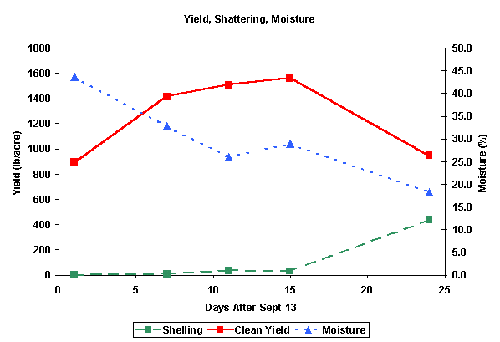
However, balanced against the increasing yield is the increasing risk of shelling loss as the crop matures and dries down, and the experienced increase in harvesting difficulty as the stalk dries and fibre becomes more prone to wrapping and plugging the combine. Much of the loss depicted in the graph occurred in a single high wind day, two days prior to the treatment date of harvest.
The grower thus needs to make a judgment call, weighing the increasing yield, reduced drying costs by allowing more field dry-down, and other quality benefits, vs. risk of shelling loss and combining difficulty. These results suggest that allowing field dry down to about 25% grain moisture content would strike an appropriate balance between these factors.
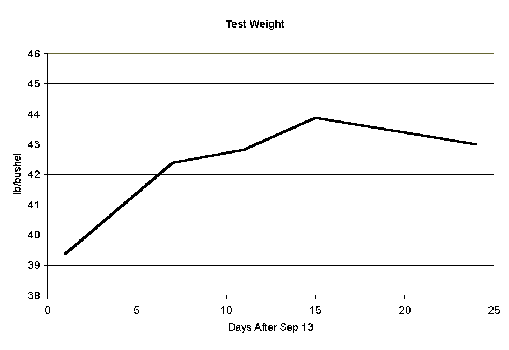
As the figure above demonstrates, test weight (a measure of grain density) increased as harvest date was delayed, by approximately 13% between Sep 14 and Sep 28. While dry seed weight did not increase over this period, the increased density would translate to decreased storage and transport volumes and thus some potential reduction in cost. The change in density could conceivably result in some impact on processing conditions, but this has not been explored.

Effects of harvest date on percent oil, protein, and fibre were not statistically significant (table above).
Fatty acid profile
Few fatty acids were affected by harvest date. Of most consequence would appear to be the decline in gamma-linolenic acid (GLA) (figure below), given its importance to the nutraceutical value of hempseed oil. This was also observed in similar analysis of data from a Manitoba Agriculture trial, but is probably of little practical importance.
The level was highest on the first harvest date, and dropped by the second harvest date, but then did not change significantly — a combine harvest could not have taken place on the first date (i.e. to "capture" this higher GLA content) because the moisture content was too high and other positive quality changes had yet to take place (as discussed earlier). In other words, this reduction in GLA content cannot become a practical consideration in determining harvest timing.
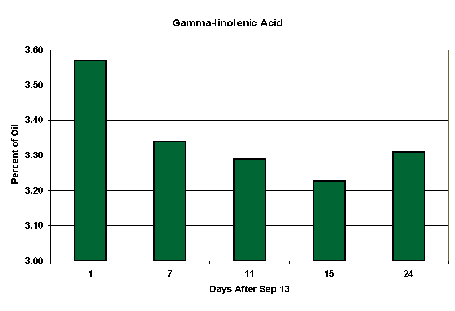
Other important components in hempseed oil include antioxidants (tocopherols or Vitamin-E) which are increasingly recognised for their therapeutic or nutraceutical value, and sterols which may have anti-cholesterol benefits. Anti-oxidants in hempseed oil also probably perform a stabilising function—the highly polyunsaturated character of the oil carries an increased propensity to rancidity or spoilage. With delayed harvest, tocopherols increased significantly and sterols decreased significantly (figure below). Since it seems that the tocopherols presently have greater marketing importance, the increasing tocopherol content with delayed harvest is another factor in favour of waiting to combine until moisture has dropped to approximately 25%.
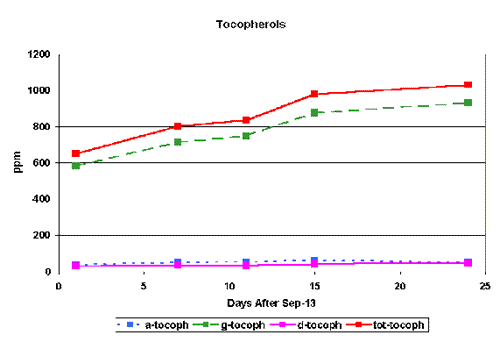
Conclusion
As moisture declined from c. 40% into the low 20% range:
As moisture dropped below approx. 25% range:
In conclusion, regarding optimum harvest timing:
Jack Moes PhD, P.Ag., C.A.C., is a consulting agrologist and authorised crop inspector with great experience with hemp. He works out of Manitoba and the West through his company The Great AgVenture and can be reached at: agventure@mb.sympatico.ca
The research activities documented in this report were made possible through funding from the Governments of Manitoba and Canada through the Canada-Manitoba AgriFood Research and Development Initiative (ARDI).
End of Part II
To go to part III, Click Here
______________________________________________________________________
© 1999-2000 AHEM/HCFR PUBLISHING. INDIVIDUAL ARTICLES REMAIN PROPERTY OF THE AUTHOR (S). NOT TO BE DUPLICATED FOR FINANCIAL OR PERSONAL GAIN. CONTACT US ABOUT REPRODUCTION RIGHTS. CLAIMS MADE BY ADVERTISERS DO NOT IMPLY ENDORSEMENT BY THE PUBLISHER.